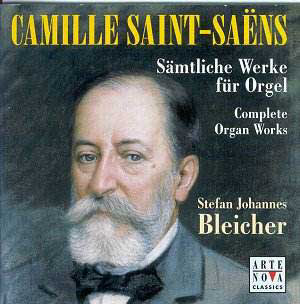 Composer: Camille Saint-Saëns
Composer: Camille Saint-Saëns
Works: Complete Organ Works
Performers: Stefan Johannes Bleicher (organ)
Recording: Recorded 21-23 March 1995 at Johanneskirche, Schaffhausen, and 6-7 February 1995 at Stadtkirche, Winterthur.
Label: Arte Nova
The organ works of Camille Saint-Saëns are often overshadowed by his more popular orchestral compositions, notably the Symphony No. 3, which prominently features the instrument. Yet, this comprehensive collection offers an illuminating glimpse into the composer’s mastery of the organ, revealing a rich tapestry of stylistic influences and technical prowess. The works span his career, from early pieces written in the mid-19th century to his final compositions in the twilight of his life, providing a unique perspective on how his style evolved over time while remaining rooted in classical traditions.
Stefan Johannes Bleicher’s interpretations are marked by a commanding technique and a nuanced understanding of the repertoire. His performances of the earlier works, such as the Première Fantaisie in E flat major and the Offertoire in E major, exhibit a youthful exuberance tempered by the lyrical grace that characterizes much of Saint-Saëns’s output. The Prélude in C major is rendered with a delicate touch, allowing the melodic lines to sing above the rich harmonic underpinning. Bleicher’s registration choices are particularly commendable; his ability to color the soundscape enhances the textural clarity of the music without overwhelming its inherent simplicity.
The more substantial works, particularly the Trois Préludes et Fugues, Op. 99 and Op. 109, showcase Saint-Saëns’s contrapuntal skill and Bleicher’s adeptness at navigating complex structures. The Fugues exhibit a meticulous attention to detail, with Bleicher’s phrasing revealing the intricate interplay of voices. However, there are moments when his expressive rubato appears to stretch the rhythmic integrity, leading to a somewhat loose interpretation that may detract from the precision expected in such works. Nevertheless, his performances are generally authoritative, and the thematic development in pieces like the Deuxième Fantaisie is handled with both sophistication and clarity.
The recording quality is exemplary, capturing the resonant acoustics of the venues while ensuring that the intricate textures of the organ are rendered with lucidity. The balance between the organ’s powerful registrations and the subtler passages is finely calibrated, allowing for a dynamic listening experience. The engineering effectively preserves the instrument’s tonal richness; the weighty chords resonate without becoming muddied, affirming the recording’s high production values.
While this collection is undoubtedly a treasure for those seeking a comprehensive survey of Saint-Saëns’s organ works, it is worth noting that not all pieces possess equal weight. Some of the shorter compositions, such as the brief O salutaris hostia, feel sketchy and lack the thematic development found in the more substantial works. For listeners primarily interested in the most significant contributions to the organ repertoire, alternative recordings, such as Margaret Phillips’s single-disc recital which focuses on the more substantial works, might prove to be a more efficient introduction.
The Arte Nova box set serves as an important document of Saint-Saëns’s organ oeuvre and offers a valuable resource for both enthusiasts and scholars alike. Bleicher’s performances, while occasionally uneven in terms of rhythmic precision, are imbued with a deep understanding of the music’s classical roots and Romantic sensibilities. For those willing to explore the complete works, this collection provides not only an engaging listening experience but also a thorough grounding in the evolution of Saint-Saëns’s organ music throughout his long and distinguished career.



